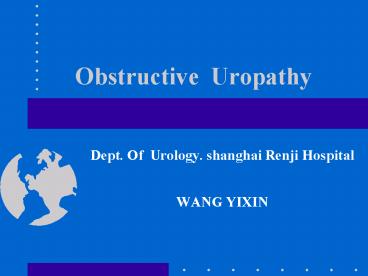Obstructive Uropathy PowerPoint PPT Presentation
1 / 20
Title: Obstructive Uropathy
1
Obstructive Uropathy
- Dept. Of Urology. shanghai Renji Hospital
- WANG YIXIN
2
General Conception
- Stone
- Obstruction
- Infection Renal
function - 1.Obstruction eventually Leads to decompensation
of the muscular conduits and reservoirs,back
pressure,and atrophy of renal parenchyma. - 2.It also invites infection and stone formation.
3
Pathologic consequences
-
infravesical - Level of obstruction
-
supravesical -
complete - Degree of obstruction
-
partial - Nature of obstruction
infection,injury,stone, -
tumor - Duration of obstruction
4
The conseqences include
- Incresed intraluminal pressure
- urinary stasis
- infection
- stone formation
- loss of renal function
5
Etiology
- Congenital
- meatal stenosis
- ureteral strictures
- posterior urethral strictures
- ureterovesical junction obstruction
- ureteropelvic junction obstruction
- (various causes)
- neurologic deficites
- Acguired
- urethral strictures inflammatory
- or traumatic
- bladder outlet obstruction
- (BPH or PCA)
- vesical tumor
- neuroginec bladder
- extrinsic ureteral compression
- ureteral or pelvic stones, strictures and tumor
6
The causes of hydrocalycosis
7
The causes of hydronephrosis
8
Pathogenesis (patholophysiology)1
- The changes in the various segments in the
urinary tract, depending on the obstructive
severity and duration - 1. Urethral changes dilatation, diverticulum
- 2. Vesical changes trabeculation, residual
urine, - diverticula
- 3. Ureteral changes distention, dilatation and
lengthening
9
(No Transcript)
10
(No Transcript)
11
Pathogenesis (patholophysiology)2
- 4. Pelvicalyceal changes first shows evidence of
hyperactivity and hypertrophy and then
progressive dilatation and stony,rounding of the
fornices ,followed by flattening of the papillae
and finally clubbing of the minor calyces. - 5. Renal Parenchymal Changescompression,
ischemic atrophy.
12
The result of renal pelvis-obstruction
13
Clinical findings
- 1.Symptoms and signs
- infravesical obstruction difficulty of
voiding,weak stream ,diminished flow
rate,terminal dribbling,burning ,frequency. - Supravesical obstruction renal pain or renal
colic,if gradually--asymptomatic or enlarged
kidney.
14
Clinical findings
- 2.Laboratory findings
- Urinary infection
- Hematuria or Crystalluria
- Impaired kidney function
- elevated blood urea nitrogen
- and serum creatinine .
15
Clinical findings
- 3.X-Ray findings
- I.V.P , RGP , Ureterograms , Urefhrogram
- localizing the site of obstruction
- demonstrate the extent of the obstructed segment
- anatomic changes
- functional changes
16
Clinical findings
- 4.Special Examination
- Instrumental calibration of sites of
obstruction is also valuable - isotope renography
- ultrasonic examination shows hydronephrosis and
residual urine - urineflow rate
- CT.
17
Treatment
- 1.bladder drainage by a catheter
- 2.urethral stricture can be dilatated or
urethrotomy or urethroplasty - 3.urethral valves must be ruptured
- 4.BPH or obstructing bladder tumors require
surgical removal - 5.impacted stones must be removed
18
Treatment
- 6.ureteral or ureteropalvic obstruction requires
surgical revision and plastic repair - ureterovesicoplasty
- ureterolithotomy
- ureteroureteral anastomosis
- bladder flaps to bridge a gap in the lower ureter
- transureteroureteral anastomosis
- ureteropyeloplasty
19
Treatment
- Preliminary drainage above the obstruction is
sometimes needed to improve kidney function. - Occasionally, permanent drainage and diversion by
cutaneous ureterostomy, ileal or colonic loop
diversion, or permanent nephrostomy are required.
20
Prognosis
- The prognosis depends on the cause, site,
duration, and degree of kidney demage and renal
decompensation. In general, relief of obstruction
leads to improvement in kidneys,especially those
destroyed by inflammatory scarring.

